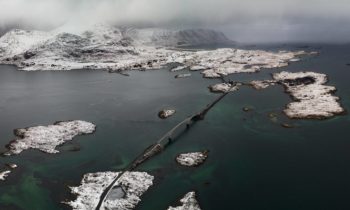
*** EXCLUSIVE – VIDEO AVAILABLE ***
LOFOTEN, NORWAY – APRIL 2016: While Joel was in Norway the sun was out for nearly 20 hours a day giving him the chance to make the most of the soft light in Lofoten, Norway, April 2016.
Submerge yourself in the fantastical natural beauty of Norways Lofoten Islands with these stunning landscapes. While leading a photo tour with fellow photographer Magali Tarouca, Joel Santos dedicated as much time as possible to documenting the regions famous scenery with his drone camera. The Portuguese photographer spent five days travelling over 1500km to thoroughly scout the locations before the participants arrived.With darkness only creeping in for a few hours in the early morning, Joel only slept for a few hours a night to take full advantage of the light and to capture the towns and villages of Reine, Hamnøy, Sakrisøya, Olenilsøya, Unstad, Uttakleiv, Nusfjord, Henningsvær and Fredvang.
PHOTOGRAPH BY Joel Santos / Barcroft Images
London-T:+44 207 033 1031 E:hello@barcroftmedia.com –
New York-T:+1 212 796 2458 E:hello@barcroftusa.com –
New Delhi-T:+91 11 4053 2429 E:hello@barcroftindia.com www.barcroftmedia.com (Photo credit should read Joel Santos / Barcroft Images / Barcroft Media via Getty Images)
Oslo’s fjords, inlets of glacier-derived waters ensconced by steep cliff-sides, might look pristine and majestic in the winter, but reveal hidden aggregations of garbage beneath when thawed. Amongst the environmentally disconcerting hunks of trash are abandoned cars and plastic materials that damage local marine life. In addition to Oslo eagerly working to become the first major European city to establish car-free zones by 2019, it is now proactively looking toward drone technology to combat its polluted Fjords beneath.
According to The New York Times, the depths of Norway’s southern fjords likely contain historically significant items like sunken Viking ships and World War II materials, in addition to potential homicide victims and general trash. It is the latter, that environmentalists in the area are keen on combating via unmanned vehicles equipped with drone technology. The reason these fjords have swallowed such an abundance of garbage is that they’ve provided a popular method of disposal. “Not many years ago, a mayor said if you want to get rid of a car, put it on ice,” said Solve Stubberud, general secretary of the Norwegian Divers Federation.
Not many years later, fortunately, the capital is keenly eyeing drone tech to proactively clean its surroundings. “We will test out drones,” said Svein Olav Lunde, chief technical officer of the Oslo Port Authority, to clear away the “islands of trash” under water. According to board member Geir Rognlien Elgvin, the city’s port will be the first in the world to attempt a drone-assisted clean up of this kind. The drones themselves will essentially dive beneath the surface and locate substantial build-ups of trash, so that the electric-powered ship they deploy from can utilize its crane to assist in removal.
As The New York Times is wise to point out, Norwegians have a strong sense of pride and justice when it comes to their environment, having collectively been disgusted in January by images on social-media of dead dolphin trapped in plastic. This loud, moral compass which is further evident by the city’s plans on designating car-free zones in certain areas was awarded the European Green Capital Award for 2019. It’s no surprise then, that the city is working on yet another way to improve environmentally, this time, through drone technology.
“Plastic is the real problem,” said Stubberud. He claims that that besides politicians publicly voicing their interest in fighting pollution, it’s the environmentalists driving the ambitious plans exemplified by this new drone-tech approach. Unfortunately, Norway’s government allows mines to dump their waste offshore, providing for a frustrating situation where one initiative could really begin to make a difference, and an active legislation allowing for waste to be dumped into the ocean on a regular basis.
Christine Spiten, a drone pilot and tech entrepreneur, would describe the amount of trash in the fjords as vast. “There are whole households of furniture,” she explained. Having showcased Blueye’s Pioneer remote operated vehicle (ROV) drone to Oslo Port Authority representatives in February, during which she found a rusty bicycle underwater, she argued for the technology’s convenience and functionality. Hopefully for her, the citizens of Oslo and every other living thing on this Earth, our collective tech advancements continue to be used for environmental clean-up in the area.
(thedrive)
